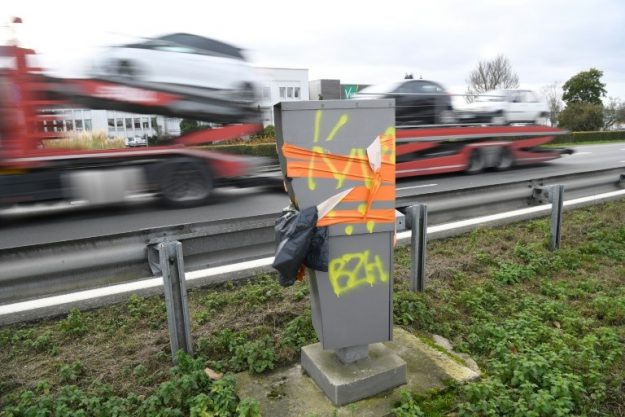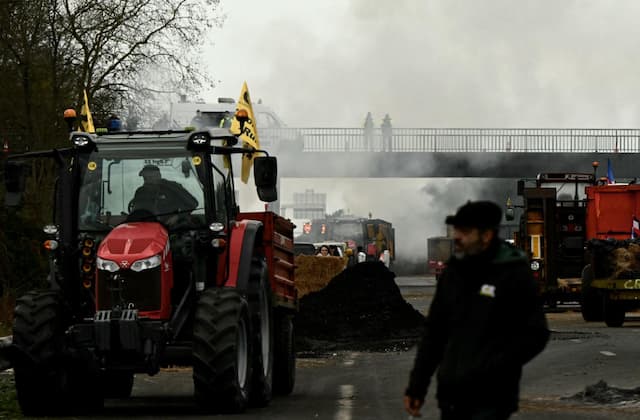Yellow Vests: Almost 60% of Damaged Radars, Tens of Millions of Euros of Damage

Interior Minister Christophe Castaner gave an update on the degraded radars since the beginning of the movement. Road Safety deplores a “dramatic phenomenon”.
Burned, tagged, sheeted , repainted, covered with a yellow vest, or downright demolished. These are images that have probably not escaped you on the roads since mid-November 2018, starting point of the movement of yellow vests : many radars have been targeted.
However, the authorities have never communicated in this regard by officially quantifying the damage. It is now done, with the speech of the Minister of the Interior Christophe Castaner Thursday, January 10 during the vows at the gendarmerie:
“Nearly 60% of the radars have been neutralised, attacked, destroyed by those who claim this movement.”
The authorities refuse to communicate more precise figures, “to avoid overbidding and the spread of the phenomenon,” noting that some of these radars “degraded” throughout the country since mid-November have already been rehabilitated of use. Nearly 3200 fixed speed cameras are deployed throughout the country.
From 60,000 to 200,000 euros of repairs by radar
Road Safety ensures that it does its utmost to repair and replace damaged radars. But the cost of intervention can quickly blaze, depending on the type of aircraft and the damage caused: 500 euros on average for a tag or a broken window on any type of radar, between 60 000 and 80 000 euros for fixed speed cameras and discriminants, 75,000 euros for “construction” radars and up to 120,000 or 200,000 euros for radars that calculate the average speed.
“We estimate that the total cost of damage should amount to several tens or even hundreds of millions of euros, in repairs and lost revenue.”
Emmanuel Barbe, Interministerial Delegate for Road Safety , joined by actu.fr , insists that these repairs will be financed by public money, the product of revenue from radar fines. “It’s the taxpayers who will pay, including the perpetrators. ”
Up to five years in prison
Christophe Castaner promised “no complacency” against the radar breakers. A slight deterioration is punishable by a fine of 3,750 euros and a penalty of community service. Heavy degradation is punishable by a fine of 30 to 75,000 euros depending on the circumstances and five years in prison . To the fine is added the sentence for the compensation of the damage suffered by the State.
Twenty individuals have been arrested since the beginning of the movement for degradations and must be tried by a criminal court.
“Each degradation is the subject of a systematic complaint from the prefectural services concerned.”

Speeding up
Immediate consequence of these damages: the number of speeding surges jumped 20% in December, according to Road Safety. Because even damaged, the radars still work. “What you have to understand from a radar is that it has two systems: one that measures speed, and one that takes a picture when the speed exceeds that allowed. Currently, a certain number of radars measure the speed but are no longer able to take photographs, “explains Emmanuel Barbe.
The Road Safety representative is saddened:
“What is happening is very sad and very serious. By committing these acts, these people ruin the lives of others, putting themselves and their loved ones at risk. When we destroy radars, we put the lives of motorists in danger. “
The phenomenon worries, while the authorities have managed to reverse the trend of increasing the number of deaths recorded since 2014 ( 3684 killed in 2017 ).
The road death toll for 2018, expected at the end of January, looks to be improving: with 3176 deaths over the first eleven months of the year, France counted in November 193 killed by less than in November 2017, which should to reach a level close to the all-time low of 2013 (3427 killed).
According to official figures, speed cameras have saved 23,000 lives between 2003 (date of installation of the first aircraft) and 2012.
Questioning the limitation to 80 km/h
This explosion of attacks against radars is for some a way to denounce the lowering, from the 1st of July, the speed limit of 80 km / h on secondary roads. This measure is, according to critics, a new manifestation of the “racketeering” of the state. For the government, it must save up to 400 lives a year.
“There is no politics of numbers, there is a politics of life,” said Minister Christophe Castaner, calling those who attack radars “fools, unconscious, inconsistent “ .
For the general delegate of the association 40 million motorists , Pierre Chasseray, this measure does on the contrary “only to put in the illegality of the motorists who are not furious fools while rolling at 85 or 90 km/h”:
“The 80 km/h is not effective, it only helps blacken the spirit of motorists and yellow jackets.”
An article in the Parisian Friday reveals that behind the scenes of the state, alternatives to the 80 km/h would already be considered, according to the wishes of ” some elected representatives of the majority, the opposition but also former ministers.” One of the avenues envisaged would be to allow the prefects to make case by case and to select the sections on which this limitation could be lifted.
But there is no question of going back on this limitation at the moment, assures Emmanuel Barbe. “We will make an initial assessment of this measure in late January, six months after its entry into force. “
Enjoyed this? Get the week’s top France stories
One email every Sunday. Unsubscribe anytime.


